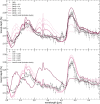Early Release Science of the exoplanet WASP-39b with JWST NIRSpec PRISM
- PMID: 36623548
- PMCID: PMC9946832
- DOI: 10.1038/s41586-022-05677-y
Early Release Science of the exoplanet WASP-39b with JWST NIRSpec PRISM
Abstract
Transmission spectroscopy1-3 of exoplanets has revealed signatures of water vapour, aerosols and alkali metals in a few dozen exoplanet atmospheres4,5. However, these previous inferences with the Hubble and Spitzer Space Telescopes were hindered by the observations' relatively narrow wavelength range and spectral resolving power, which precluded the unambiguous identification of other chemical species-in particular the primary carbon-bearing molecules6,7. Here we report a broad-wavelength 0.5-5.5 µm atmospheric transmission spectrum of WASP-39b8, a 1,200 K, roughly Saturn-mass, Jupiter-radius exoplanet, measured with the JWST NIRSpec's PRISM mode9 as part of the JWST Transiting Exoplanet Community Early Release Science Team Program10-12. We robustly detect several chemical species at high significance, including Na (19σ), H2O (33σ), CO2 (28σ) and CO (7σ). The non-detection of CH4, combined with a strong CO2 feature, favours atmospheric models with a super-solar atmospheric metallicity. An unanticipated absorption feature at 4 µm is best explained by SO2 (2.7σ), which could be a tracer of atmospheric photochemistry. These observations demonstrate JWST's sensitivity to a rich diversity of exoplanet compositions and chemical processes.
© 2022. The Author(s).
Conflict of interest statement
The authors declare no competing interests.
Figures














Comment in
-
JWST opens a window on exoplanet skies.Nature. 2023 Feb;614(7949):632-633. doi: 10.1038/d41586-023-00394-6. Nature. 2023. PMID: 36792896 No abstract available.
References
-
- Seager S, Sasselov DD. Theoretical transmission spectra during extrasolar giant planet transits. Astrophys. J. 2000;537:916–921. doi: 10.1086/309088. - DOI
-
- Brown TM. Transmission spectra as diagnostics of extrasolar giant planet atmospheres. Astrophys. J. 2001;553:1006–1026. doi: 10.1086/320950. - DOI
-
- Hubbard WB, et al. Theory of extrasolar giant planet transits. Astrophys. J. 2001;560:413–419. doi: 10.1086/322490. - DOI
-
- Zhang X. Atmospheric regimes and trends on exoplanets and brown dwarfs. Res. Astron. Astrophys. 2020;20:099. doi: 10.1088/1674-4527/20/7/99. - DOI
Publication types
Grants and funding
LinkOut - more resources
Full Text Sources

